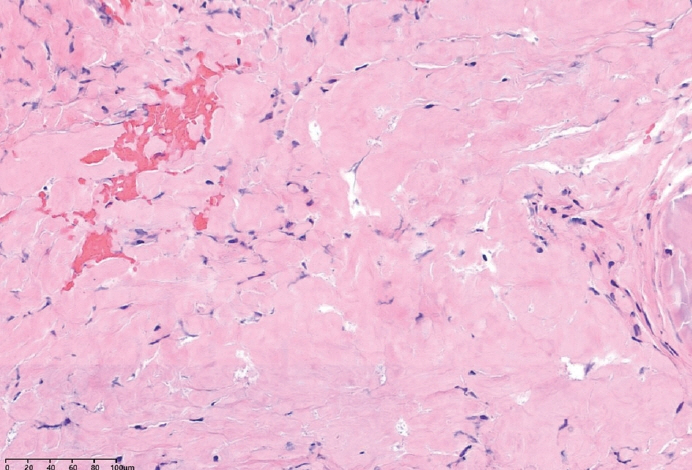J Rhinol.
2023 Nov;30(3):177-180. 10.18787/jr.2023.00043.
A Case of Bilateral Trigeminal Amyloidoma Diagnosed Through an Endoscopic Transsphenoidal Approach
- Affiliations
-
- 1Department of Otorhinolaryngology-Head and Neck Surgery, Ilsan Paik Hospital, Inje University College of Medicine, Goyang, Republic of Korea
- 2Department of Otorhinolaryngology-Head and Neck Surgery, Samsung Medical Center, Sungkyunkwan University School of Medicine, Seoul, Republic of Korea
- KMID: 2548197
- DOI: http://doi.org/10.18787/jr.2023.00043
Abstract
- Amyloidosis is a systemic disease characterized by the accumulation of amyloid protein in multiple organs. Amyloidoma, in contrast, is an uncommon localized form of amyloidosis that presents as a single mass or tumor-like lesion. Primary amyloidoma in the central nervous system is rare, and only a few cases have been reported. Notably, the Gasserian ganglion is the most frequently affected site of amyloidoma in the central nervous system, and progressive trigeminal neuropathy is a characteristic finding. Among these cases, the bilateral occurrence of amyloidoma is exceedingly rare. In this report, we present the case of a 51-year-old woman diagnosed with bilateral trigeminal amyloidoma, confirmed by an endoscopic biopsy via the transsphenoidal approach.
Keyword
Figure
Reference
-
References
1. Merlini G, Bellotti V. Molecular mechanisms of amyloidosis. N Engl J Med. 2003; 349(6):583–96.
Article2. Swanson A, Giannini C, Link M, Van Gompel J, Wald J, McPhail E, et al. Trigeminal amyloidoma: a report of two cases and review of the literature. J Neurol Surg B Skull Base. 2020; 81(6):620–6.3. Kumar V, Abbas AK, Aster JC. Diseases of the immune system. Robbins and Cotran pathologic basis of disease. 10th ed. Philadelphia (PA): Elsevier Saunders;2020. p. 189–266.4. Unal F, Hepgül K, Bayindir C, Bilge T, Imer M, Turantan I. Skull base amyloidoma. Case report. J Neurosurg. 1992; 76(2):303–6.5. Kyle RA. Amyloidosis: a convoluted story. Br J Haematol. 2001; 114(3):529–38.
Article6. Bauer WH, Kuzma JF. Solitary tumors of atypical amyloid (paramyloid). Am J Clin Pathol. 1949; 19(12):1097–112. illust.
Article7. Fischer B, Palkovic S, Rickert C, Weckesser M, Wassmann H. Cerebral AL lambda-amyloidoma: clinical and pathomorphological characteristics. Review of the literature and of a patient. Amyloid. 2007; 14(1):11–9.
Article8. Lachmann HJ, Hawkins PN. Systemic amyloidosis. Curr Opin Pharmacol. 2006; 6(2):214–20.
Article9. Hashmi H, Dhanoa J, Manapuram S. Trigeminal amyloidoma: case report and review of literature. Cureus. 2018; 10(12):e3795.
Article10. Gottfried ON, Chin S, Davidson HC, Couldwell WT. Trigeminal amyloidoma: case report and review of the literature. Skull Base. 2007; 17(5):317–24.
Article11. Gültaşli N, van den Hauwe L, Bruneau M, D’Haene N, Delpierre I, Balériaux D. Bilateral Meckel’s cave amyloidoma: a case report. J Neuroradiol. 2012; 39(2):119–22.
Article12. Vorster SJ, Lee JH, Ruggieri P. Amyloidoma of the gasserian ganglion. AJNR Am J Neuroradiol. 1998; 19(10):1853–5.13. Bornemann A, Bohl J, Hey O, Störkel S, Gamm H, Müller-Forell W, et al. Amyloidoma of the gasserian ganglion as a cause of symptomatic neuralgia of the trigeminal nerve: report of three cases. J Neurol. 1993; 241(1):10–4.
Article




